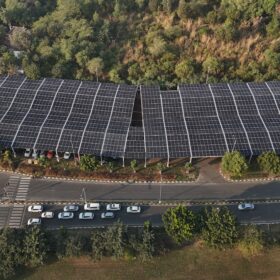From pv magazine Global
The global average levelized cost of energy (LCOE) from solar power fell 13% last year, despite the significant rise in materials costs and panel prices.
That was partly because so many of the world’s large-scale solar projects have a long lead in times and contractual clauses limiting cost increases, according to a new report published by the International Renewable Energy Agency (IRENA) this week. The result was a global solar electricity cost of $0.048/kWh, according to the IRENA study. China once again posted the lowest solar LCOE at $0.034/kWh in 2021, but there were notable reductions in Australia, where solar was 21% cheaper than in 2020, at $0.042/kWh. Japan, meanwhile, recorded a 17% year-on-year decline to $0.086/kWh.
India offered the world’s second cheapest solar power, at $0.035/kWh, in part thanks to the world’s lowest PV project costs which, at $590 per kilowatt of generation capacity installed, were 6% lower than Chinese solar farm prices. Most of the world’s biggest markets saw their solar plant investment costs fall in 2021, but policy uncertainty in pre-invasion Ukraine drove up project expenses by 17%, year on year, resulting in a solar LCOE of $1.117/kWh.
Spain also saw project costs rise by 3%. That reflected the hyper-competitive, unsubsidized plants that came online in 2020, but did not appear on the same scale last year, when developments cost an average $916 per kilowatt and the LCOE was $0.048/kWh. Vietnam posted a solar LCOE of $0.046/kWh last year, with solar electricity costing $0.055 per unit of power in the United States, and $0.064 in Turkey.
The report’s authors suggest the solar price rises bottled up last year are likely to feed into the market this year in the shape of 3% to 5% project cost increases – of $20 to $60 per kilowatt installed – in the world’s 10 biggest solar markets. That would translate into a 2% to 4% rise worldwide for utility-scale solar and a 2% global rise in the cost of solar electricity.
The document pointed out, however, the soaring price of fossil fuels this year, in particular gas, means the solar capacity added last year – and accumulated to date – has brought huge savings. The report stated: “It remains remarkable that more effort has not been made to accelerate renewable power generation deployment in 2022, over the past nine months.”
IRENA estimated the solar capacity added last year reduced power generation costs by around $11.3 billion, compared with today’s fossil fuel costs, including a $1.3 billion saving in non-OECD countries. The solar added in such nations from 2010 to last year is saving around $2.7 billion per year at today’s fossil fuel prices, the report added.
For its headline figure, IRENA said almost two-thirds of the clean power generation capacity added in 2021 (some 163 GW) was installed at a lower cost than the cheapest fossil fuel-based alternative.
This content is protected by copyright and may not be reused. If you want to cooperate with us and would like to reuse some of our content, please contact: editors@pv-magazine.com.









By submitting this form you agree to pv magazine using your data for the purposes of publishing your comment.
Your personal data will only be disclosed or otherwise transmitted to third parties for the purposes of spam filtering or if this is necessary for technical maintenance of the website. Any other transfer to third parties will not take place unless this is justified on the basis of applicable data protection regulations or if pv magazine is legally obliged to do so.
You may revoke this consent at any time with effect for the future, in which case your personal data will be deleted immediately. Otherwise, your data will be deleted if pv magazine has processed your request or the purpose of data storage is fulfilled.
Further information on data privacy can be found in our Data Protection Policy.